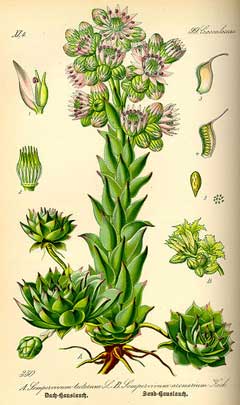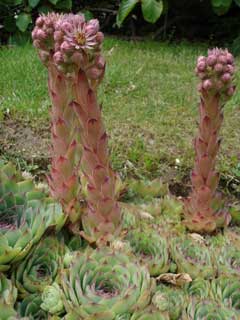 |
|
http://commons.wikimedia.org/wiki/File:Illustration_Sempervivum_tectorum0.jpg |
 |
| http://fr.wikipedia.org/wiki/Utilisateur:Bouba |
Translate this page:
Summary
Bloom Color: Pink, Purple, Red. Main Bloom Time: Early summer, Late summer, Mid summer. Form: Rounded.
Physical Characteristics

 Sempervivum tectorum is an evergreen Perennial growing to 0.2 m (0ft 8in) by 0.2 m (0ft 8in) at a medium rate.
Sempervivum tectorum is an evergreen Perennial growing to 0.2 m (0ft 8in) by 0.2 m (0ft 8in) at a medium rate.
See above for USDA hardiness. It is hardy to UK zone 4 and is not frost tender. It is in leaf all year, in flower from June to July, and the seeds ripen from July to August. The species is hermaphrodite (has both male and female organs) and is pollinated by Insects.
Suitable for: light (sandy) and medium (loamy) soils and prefers well-drained soil. Suitable pH: mildly acid, neutral and basic (mildly alkaline) soils. It cannot grow in the shade. It prefers dry or moist soil and can tolerate drought.
UK Hardiness Map
US Hardiness Map
Synonyms
Plant Habitats
Cultivated Beds; East Wall. In. South Wall. In. West Wall. In.
Edible Uses
Edible Parts: Leaves Shoots
Edible Uses: Drink
Young leaves and shoots - raw[9]. They can be eaten in salads[9]. The juice of the leaves is used as a refreshing drink[105, 177].
References More on Edible Uses
Medicinal Uses
Plants For A Future can not take any responsibility for any adverse effects from the use of plants. Always seek advice from a professional before using a plant medicinally.
Antidiarrhoeal Antipruritic Astringent Diuretic Odontalgic Refrigerant Stings Vulnerary
Warts
Houseleek leaves and their juice are used for their cooling and astringent effect, being applied externally to soothe many skin conditions. As with many other remedies that are both astringent and soothing, houseleek simultaneously tightens and softens the skin. The fresh leaves are astringent, diuretic, odontalgic, refrigerant and vulnerary[4, 9, 13, 21, 46, 61]. They are used as a poultice in much the same way as Aloe vera in the treatment of a wide range of skin diseases, burns, scalds, bites and stings etc and have also been used to get rid of warts and corns[4, 200, 238, 257]. The plant is also sometimes used internally in the treatment of shingles, skin complaints and haemorrhoids, though some care is required since in excess the plant is emetic and purgative[238]. The leaves are harvested as required and used fresh[238].
References More on Medicinal Uses
The Bookshop: Edible Plant Books
Our Latest books on Perennial Plants For Food Forests and Permaculture Gardens in paperback or digital formats.

Edible Tropical Plants
Food Forest Plants for Hotter Conditions: 250+ Plants For Tropical Food Forests & Permaculture Gardens.
More

Edible Temperate Plants
Plants for Your Food Forest: 500 Plants for Temperate Food Forests & Permaculture Gardens.
More

More Books
PFAF have eight books available in paperback and digital formats. Browse the shop for more information.
Shop Now
Other Uses
References More on Other Uses
Cultivation details
Landscape Uses:Alpine garden, Container, Ground cover, Rock garden. Prefers a well-drained gritty soil in full sun[200]. Succeeds in any sandy soil[1], doing well in very little soil in rock crevices, walls, paths etc so long as there is sufficient humus[200]. Established plants are very drought tolerant[4, 200] and dislike winter wet[200]. One of the many common names for this plant is rather interesting, but was too long to put in the common name entry earlier in this record. It is 'Welcome home husband, however drunk you be'. The plant is sometimes planted in thatched roofs since it is supposed to give protection against lightning, thunderbolts and fire to any house that it grows on[100]. It is also said to preserve the thatch[4, 115]. There is some justification to this belief because the leaves contain a great deal of water and do not burn easily - if there are many of the plants growing on the roof then they will tend to put out the fire before it can take hold properly. Individual rosettes die after flowering, but usually produce a number of offsets that continue to grow[188]. A polymorphic species, it is divided into a number of sub-species by some botanists[200]. Special Features:
Attractive foliage, Edible, Not North American native.
References Carbon Farming Information and Carbon Sequestration Information
Temperature Converter
Type a value in the Celsius field to convert the value to Fahrenheit:
Fahrenheit:
The PFAF Bookshop
Plants For A Future have a number of books available in paperback and digital form. Book titles include Edible Plants, Edible Perennials, Edible Trees,Edible Shrubs, Woodland Gardening, and Temperate Food Forest Plants. Our new book is Food Forest Plants For Hotter Conditions (Tropical and Sub-Tropical).
Shop Now
Plant Propagation
Seed - surface sow in early spring in a cold frame. It usually germinates in 2 - 6 weeks at 10°c. Prick out the seedlings into individual pots when they are large enough to handle and grow them on in the greenhouse for their first winter. Plant them out into their permanent positions in the summer if they have made sufficient growth, otherwise grow them on for a further year in pots before planting them out[K]. Division of offsets in spring or early summer. Larger divisions can be planted out direct into their permanent positions. We have found it best to pot up the smaller divisions and grow them on in a lightly shaded position in a cold frame, planting them out once they are well established in the summer. Plants can also be divided in September but these divisions should be overwintered in a greenhouse. Stem cuttings.
Other Names
If available other names are mentioned here
Native Range
EUROPE: Austria, Switzerland, Germany (south), Hungary (south), Poland (west), Italy, Montenegro, Serbia, Slovenia, Spain, France AFRICA: Morocco
Weed Potential
Right plant wrong place. We are currently updating this section.
Please note that a plant may be invasive in one area but may not in your area so it's worth checking.
Conservation Status
IUCN Red List of Threatened Plants Status :

Growth: S = slow M = medium F = fast. Soil: L = light (sandy) M = medium H = heavy (clay). pH: A = acid N = neutral B = basic (alkaline). Shade: F = full shade S = semi-shade N = no shade. Moisture: D = dry M = Moist We = wet Wa = water.
Now available:
Food Forest Plants for Mediterranean Conditions
350+ Perennial Plants For Mediterranean and Drier Food Forests and Permaculture Gardens.
[Paperback and eBook]
This is the third in Plants For A Future's series of plant guides for food forests tailored to
specific climate zones. Following volumes on temperate and tropical ecosystems, this book focuses
on species suited to Mediterranean conditions—regions with hot, dry summers and cool, wet winters,
often facing the added challenge of climate change.
Read More
Expert comment
Author
L.
Botanical References
17200
Links / References
For a list of references used on this page please go here
Readers comment